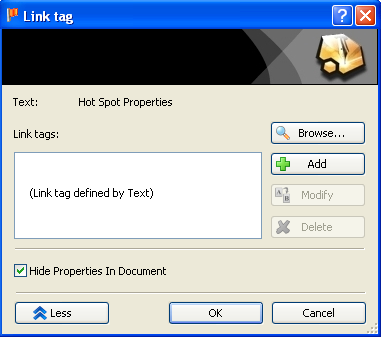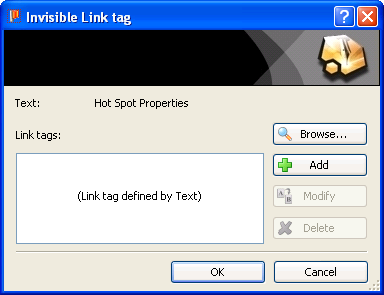The Link Tag and Invisible Link Tag hot spots assign a link tag to the topic containing the hot spot. Link tags are automatically created for topic headings formatted with a paragraph style that has its AutoLink property set to True in the Doc-To-Help project. If you want to create additional link tags for the topic; the Link Tag and Invisible Link Tag hot spots allow you to do so. The difference between the two hot spot types is that the text of the Invisible Link Tag hot spot does not appear in the help target.
The Behavior property of these hot spot types is set to Link Tag. The following predefined styles have this Behavior, and the corresponding HTML tag or Word Style can be used when formatting without the D2HML Styles toolbar:
|
D2HML Style |
Corresponding HTML Tag |
Corresponding Word Style |
|
C1H Link Tag (Hidden=False) |
<span class="C1HLinkTag"></span> |
C1H Link Tag |
|
C1H Link Tag Invisible (Hidden=True) |
<span class="C1HLinkTagInvisible"></span> |
C1H Link Tag Invisible |
The following properties are supported by this hot spot type:
|
Supported Properties: |
Description |
|
linktag |
This is the link tag assigned to the topic containing this hot spot. The characteristics of this property are: • Primary • Default • Collection • Case-insensitive |
To create a Link Tag hot spot, select the link text and
secondary part, if it exists, and press Link Tag ![]() or Invisible Link Tag
or Invisible Link Tag ![]() on the D2HML
Styles toolbar. Use the Link Tag or Invisible Link Tag dialog
box to specify the properties of the link tag.
on the D2HML
Styles toolbar. Use the Link Tag or Invisible Link Tag dialog
box to specify the properties of the link tag.

Link Tag Dialog Box

Invisible Link Tag Dialog Box
Click the More button ![]() to access additional properties.
When the More button is clicked while using this dialog box in Word, you
may select the Hide Properties in Document checkbox to hide the
properties in your source document. To show the properties, uncheck the Hide
Properties in Document checkbox, or select Tools | Options in Word
and on the View tab, check the Hidden text checkbox.
to access additional properties.
When the More button is clicked while using this dialog box in Word, you
may select the Hide Properties in Document checkbox to hide the
properties in your source document. To show the properties, uncheck the Hide
Properties in Document checkbox, or select Tools | Options in Word
and on the View tab, check the Hidden text checkbox.
If you are not using the toolbar, place the link text and secondary part in the corresponding HTML <Span> tag to format it with the D2HML style.
The following table gives you some examples of using the Link Tag hot spot. Each of the following hot spots appears as My Topic in the help target. The secondary part is not visible.
|
Hot Spot in Word and HTML Editor |
HTML Code |
Description |
|
My Topic |
<span class="C1HLinkTag">My Topic</span> |
The topic containing this hot spot is assigned the link tag My_Topic. |
|
My Topic |
My <span class="C1HLinkTag">Top</span>ic |
If the Link Tag style is applied only to the letters Top in MyTopic, Top becomes a hot spot, and the topic containing this hot spot is assigned the link tag Top. |
|
My Topic|linktag=Tag |
<span class="C1HLinkTag">My Topic|linktag=Tag</span> |
The topic containing this hot spot is assigned the link tag Tag. |
|
My Topic|linktag=Tag1+Tag2 |
<span class="C1HLinkTag">My Topic|linktag=Tag1+Tag2</span> |
The topic containing this hot spot is assigned link tags Tag1 and Tag2. |
|
My Topic|=Tag |
<span class="C1HLinkTag">My Topic|=Tag</span> |
The topic containing this hot spot is assigned the link tag Tag. Because linktag is the default property for the LinkTag hot spot, it does not need to be included in the secondary part. |